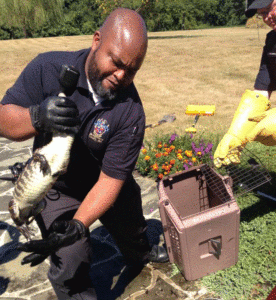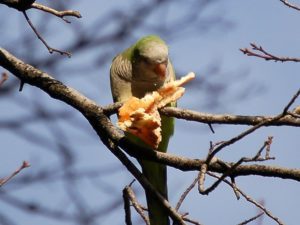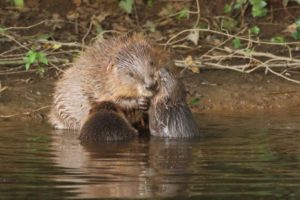Podcast: Play in new window | Download (Duration: 14:31 — 14.4MB)
Happy New Year! Let’s learn about a few animals that have shown up in places where they just shouldn’t be. How did they get there, and why? Sometimes we know, sometimes it remains a mystery.
Some of Pablo Escobar’s hippos:

King Julien, the ring-tailed lemur who was discovered almost frozen to death in London:

A little alligator captured in a koi pond. In Maryland. Which is not where gators live:

A monk parakeet eating pizza in Brooklyn, because of course it is:

How did these beavers get into a Devon river? They’re not telling:

Show transcript:
Welcome to Strange Animals Podcast. I’m your host, Kate Shaw.
Happy new year! Let’s ring in the new year with some out-of-place animals. Sometimes an animal shows up in a place where it just shouldn’t be, and while the animal itself isn’t a mystery, how it got there is. In this episode we’ll chase down the solutions to a few of these mysteries, and ponder a few others we can’t solve.
We’ll start with some hippos that aren’t hanging out in Africa where they belong, but are living in Columbia, South America. In this case, we do know what happened. Back in the 1980s, a guy named Pablo Escobar had a private zoo that contained four hippos, along with other animals. Escobar was not a nice person. He was a drug lord who grew obscenely rich from selling cocaine and killing anyone who didn’t agree with him. In 1993 the police raided his estate and Escobar was killed in a shoot-out. The government took over the estate and turned it into a park, and most of the animals were given to zoos. But the hippos stayed. The estate had a lake that they lived in, and they weren’t hurting anything.
But after a few decades, the four hippos turned into forty. The hippos have expanded their range from the park to neighboring rivers. Sometimes a hippo wanders into a neighboring town or ranch. Hippos can be dangerous—in fact, they’re the most dangerous animal in Africa, killing more people than any other animal. But the locals like the hippos. At this point the government is torn between needing to keep the people and environment safe from these out-of-place animals, and preserving animals that everyone agrees are really awesome. In 2010 the government started a program to castrate the males, which will stop the population from growing, although castrating a wild hippo is not easy so the program is not necessarily going to work.
This is what a hippo sounds like:
[hippo sound]
In December 2011, someone found an unusual animal in London, a ring-tailed lemur. Even if you don’t know what it is, you know what it is. The vets who treated the animal named him King Julien after the character from the movie Madagascar. Lemurs are primates, only found in the island country of Madagascar, so what was one doing in London on a below-freezing day? Poor King Julien almost died of hypothermia and dehydration.
King Julien was very tame, so had probably been someone’s pet. People are allowed to own lemurs in England, but only with a special license. Ring-tailed lemurs are popular exotic pets, and part of the reason they’re endangered in the wild is because they’re frequently captured for sale on the black market. I tried to find out what had happened to King Julien, without luck, but hopefully he recovered fully and now lives in a zoo or wildlife sanctuary where he can be properly cared for and can hang out with other lemurs.
This is what a ring-tailed lemur sounds like:
[ring-tailed lemur sound]
Unfortunately for many animals kept as exotic pets, once the people who buy them realize owning an alligator, for instance, is not as fun as it sounds, the animals are often just dumped outside to fend for themselves. The kind of person who would buy an exotic animal in the first place is probably not the kind of person who bothers to learn how to take care of it.
Back in the mid-20th century, if you took a vacation to Florida and went into a souvenir shop, you could buy a live baby alligator for a few bucks. Baby alligators are cute, like big lizards. But they grow fast, they eat a lot, they make a mess, and they often get sick because they’re not properly taken care of. I like to think I know a fair amount about animals, but I wouldn’t know how to take care of a baby alligator. And if it was 1950 and I couldn’t just look that information up online, or find it in the local library, I’d probably not do a very good job.
Now I know you’ve heard about sewer alligators. The story goes that back in the days when baby alligators were cheap pets, people would bring them home as souvenirs, realize very soon that they didn’t actually want an alligator as a pet, and would flush them down the toilet to get rid of them. Some of the flushed baby alligators survived, and grew up in the safety and relative warmth of the New York City sewers, eating rats. Every so often a maintenance worker would get the shock of shining a flashlight down a sewer tunnel and seeing the reflection of alligator eyes. In the stories, the gators were always enormous.
So did this ever happen? Did alligators ever really live in the sewers of New York or any other city? Alligators have actually been found in sewers, although it’s not known if they were survivors of being flushed or if they were released aboveground and found their way to the nearest water through storm drains. In 2010 a two-foot-long, or 60-centimeter, baby alligator was found in the sewer in New York City. In 1984 a Nile crocodile was captured in the Paris sewers. But a sewer is not a good habitat for any living thing, especially not a reptile. Any alligators found in sewers haven’t been there long—they wouldn’t survive long, and they certainly couldn’t breed in a cold, lightless environment.
But alligators don’t just turn up in sewers. They’re forever being found in people’s ponds, and not in Florida or surrounding areas like you’d think. As just one of many possible examples, in 2015 a guy in Maryland, in the northeastern United States, found a three foot, or .9 meter, alligator in his koi pond. Probably he did not have any koi left by the time police officers caught the gator and relocated it to a local zoo.
This is what an American alligator sounds like:
[alligator sound]
It’s not too unusual to find a bird somewhere outside of its natural range. While migrating birds have amazing skills at navigating long distances, sometimes a bird is blown off course by a storm, or joins a flock of closely related birds that then fly somewhere other than its usual migration route. But sometimes the presence of out-of-place birds aren’t so easy to figure out.
For instance, the Brooklyn parrots. Brooklyn is part of New York City, not a particularly welcoming place for tropical birds. But there’s a population of wild parrots called monk parakeets, or Quaker parrots, that have been living in the city for over 50 years. And no one’s sure where they came from.
The monk parakeet is from Argentina. It’s smallish, around 11 inches long or 29 cm, with a 19 inch wingspan, or 48 cm. It’s a cheerful bright green in color with pale gray forehead and breast, and some blue on the wings. It eats plants of all kinds and builds elaborate multi-family nests called apartments by weaving twigs together.
It’s also been a popular pet for a long time. It learns to mimic speech easily, is intelligent and hardy, and lives 15 to 20 years, or even longer. But because so many feral populations have developed in North America and Australia, some areas no longer allow monk parakeets as pets at all.
The Brooklyn parrots are probably escaped birds from pet stores and especially from shipping crates full of birds imported from Argentina. Thousands of the parrots were sold as pets in the United States during the 60s and 70s. The first report of parrots living in New York City comes from December 1970, when an article about them appeared in the New York Times. Since then, the origin of the parrots has achieved urban legend status, with unsubstantiated stories of heroic releases of captive birds from sinking cargo ships, a mass release of captive birds from an abandoned aviary, and so forth. In the mid-2000s, a poaching ring trapped birds to sell on the black market, but the ring was busted and the birds freed.
Populations of monk parakeets also live in Chicago, Austin TX, Brussels, Belgium, and many other cities. Because their droppings don’t harm statues and other structures the way pigeon droppings do, and studies of urban birds reveal that they aren’t a threat to native species, many cities have stopped trying to exterminate the birds. Their large nests do frequently have to be removed from power transformers.
This is what a monk parakeet sounds like:
[monk parakeet sound]
I always think of beavers as a North American animal, but the Eurasian beaver is native to—you guessed it—Europe and Asia. But like the North American beaver, the Eurasian beaver was almost driven to extinction by humans, who wanted its fur and a substance called castoreum that is still used in perfumes and cigarettes. Castoreum is produced by the beaver to scent mark their territory, and a beaver’s castor sacs is found right next to the anal glands. Another reason to quit smoking!
So by 1900, the Eurasian beaver was almost extinct throughout its range. Only a few small populations remained. In England, Scotland, and Wales it went extinct completely by the 16th century. But after conservation efforts throughout Europe and Asia, beavers have started to be reintroduced into their historic ranges. The first official reintroduction of beavers into Scotland occurred in 2009 and the animals are doing well.
In 2013, people in Devon, England started seeing beavers along the River Otter. The next year they had babies. No one had any idea where the beavers had come from—Devon is too far from Scotland for the Scottish beavers to have migrated there naturally, and anyway the Scottish beavers are closely monitored. If three had gone missing, the researchers in charge of them would know.
It led to a lot of controversy in Devon, to say the least. Fishers and farmers worried that the beavers would mess up the river, carry diseases, and in general cause havoc. And since the beavers hadn’t been officially introduced, no one knew whether these were even the right kind of beaver for England and if they were healthy. But locals liked having beavers around—they are really cute animals, after all. When the government agency Natural England announced it would capture the beavers and put them in a zoo, locals protested so strenuously that the plan was changed. Instead, the beavers were captured, examined by veterinarians to make sure they were Eurasian beavers and disease free, and rereleased. This happened in 2015. The beavers were healthy, they were the right species, and they were returned to the river. Still, no one one knows how they got there.
Beavers are actually good for fish and the local environment. Beaver ponds create winter habitat for many types of fish, and beaver dams don’t stop fish like salmon that migrate upriver to spawn. The presence of beaver dams helps reduce flooding, improves water quality, and creates cover for lots of fish and animals. And while some people believe beavers spread the giardia parasite, which causes a bacterial infection sometimes called beaver fever, giardia is actually mostly spread by humans and our domesticated animals, especially dogs. Giardiasis causes nasty diarrhea and other intestinal distress that can go on for weeks, and it’s why you don’t ever drink water that hasn’t been treated in some way.
The beavers in Devon are doing well and have spread into neighboring waterways. They got in the news again a little over a year ago, in October of 2016, when a rich guy decided he didn’t like them. Sir Benjamin Slade, who has a great name but who is clearly a prime jerk, posted a reward of 1,000 pounds to anyone who would kill the beavers who’d moved onto his estate, because he didn’t like that they were felling some of his trees. Dude, you are rich. Hire somebody to plant more trees for you. Besides, beavers have brought tourists to Devon who hope to catch a glimpse of the animals, which helps the local economy, Mr. Slade, if that IS your real name.
Anyway, this is what a beaver sounds like:
[beaver sound]
There are so many out-of-place animal reports that there’s no way to cover more than a few in one episode, so I’ll definitely revisit the topic. Until then, keep an eye out for anything unusual walking through your back yard.
You can find Strange Animals Podcast online at strangeanimalspodcast.com. We’re on Twitter at strangebeasties and have a facebook page at facebook.com/strangeanimalspodcast. If you have questions, comments, or suggestions for future episodes, email us at strangeanimalspodcast@gmail.com. If you like the podcast and want to help us out, leave us a rating and review on Apple Podcasts or whatever platform you listen on. We also have a Patreon if you’d like to support us that way.
Thanks for listening!